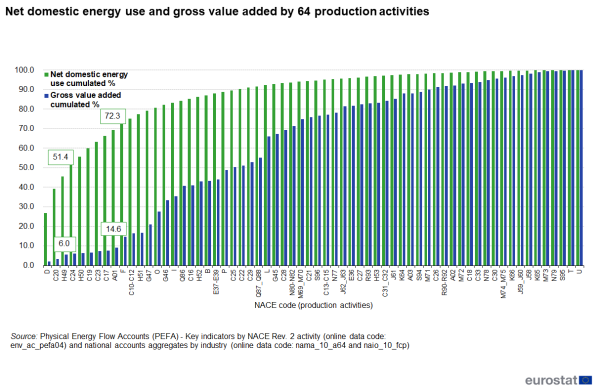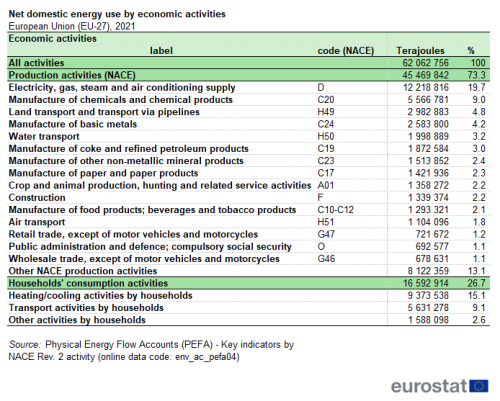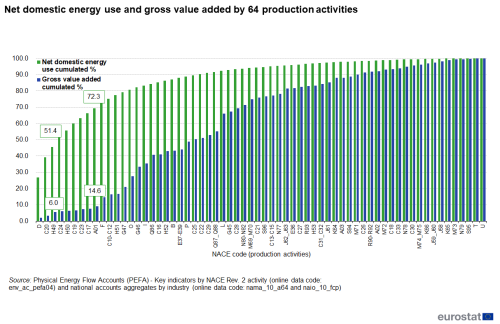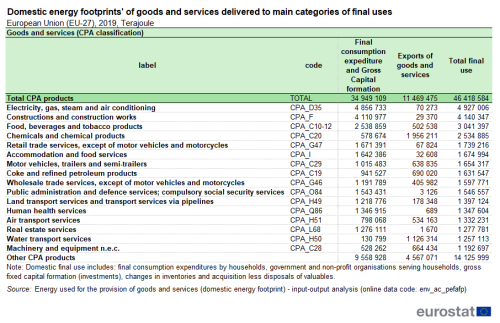Energy use by businesses and households - statistics
Data extracted in January 2024.
Planned article update: February 2025.
Highlights
Four production activities account for more than 50% of production-related energy use while contributing around 6% of EU’s GDP.
About one quarter of the energy used by the EU’s production activities is for goods and services that are exported.

European Union (EU), 2021
Source: Eurostat (env_ac_pefa04), estimations based on (nama_10_a64) and (naio_10_fcp_u3)
For list of NACE Rev 2 codes see here
The EU economy needs energy to function. Some 45.5 million Terajoules (TJ) of energy – about three quarters of the EU’s net domestic energy use – is due to domestic production activities by European businesses. This article shows which production activities have the highest energy use compared to their economic significance. It also presents products whose final use has the highest ‘domestic energy footprint’, i.e. the energy used within EU domestic supply chains that make these products available.
This article is based on European environmental-economic accounts and macro-economic modelling using national accounts data.
Full article
Main findings
In 2021, the net domestic energy use in the EU economy amounted to 62.1 million TJ (see Table 1). It includes energy used directly by households and energy used by production activities of businesses. Households account for about one quarter of net domestic energy use (16.6 million TJ), mostly for heating and cooling. The domestic producers of goods and services in the EU, i.e. businesses, account for three quarters of net domestic energy use (45.5 million TJ). The energy use related to businesses’ production activities is the focus of this article. The production activity ‘electricity, gas and steam supply’ (NACE code D) is the main energy user among economic producers, at around 20 %. With the help of economic modelling, the net domestic energy use by economic producers is attributed to the final use of products (goods and services) – referred to as ‘domestic energy footprints’ (see Table 2). Products for final consumption by households and government account for about 59 % of domestic energy footprints. Exported products account for around 25 % and investment goods for around 16 %.
Net domestic energy use – an overview
Table 1 presents net domestic energy use in a breakdown by economic activity following the concepts of national accounts. Economic activities are broken down by businesses (production activities classified according to NACE) and private households.

European Union (EU-27), 2021
Source: Eurostat (env_ac_pefa04)
Households’ direct energy use accounts for about one quarter of the net domestic energy use (16.6 million TJ). More than half of it is for heating and cooling, the other half for private transportation and other activities (e.g. electricity used for electronic devices). Businesses (production activities) account for the remaining three quarters (45.5 million TJ). Electricity, gas and steam supply (NACE code D) is the production activity with the highest share – around 20 % of net domestic energy use. This figure only includes transformation losses and own use incurred during the supply and distribution of electricity, gas and heat, while the ‘end’ use of these products is assigned to the respective end user.
The chemical industry (NACE code C20) is the second largest energy user accounting for around 9.0 % of net domestic energy use. The chemical industry uses significant amounts of energy products for non-energy purposes e.g. petroleum products used to produce plastic. Accounting for 4.8 %, land transport services (NACE code H49) rank third, and with 4.2 %, the manufacture of basic metals (NACE code C24) ranks fourth. Land transport services only include energy used by commercial companies providing land transport services by trains, trucks, vans, taxis etc. Energy uses for road transport operated by private households and other production activities are classified under the relevant NACE codes (other than H49). Water transport (NACE code H50) is the fifth biggest production activity, accounting for 3.2 % in terms of net domestic energy use.
Comparing energy use with gross value added
The breakdown of production activities into 64 classes is the same as for economic statistics (national accounts), therefore enabling joint analyses. Figure 1 compares the net domestic energy use with the gross value added (GVA) for the 64 production activities (NACE).

European Union (EU-27), 2021
Source: Eurostat (env_ac_pefa04), estimations based on (naio_10_fcp_u3) and (nama_10_a64)
For list of NACE Rev 2 codes see here
Figure 1 shows that the four main production activities in terms of energy use account for more than half (51.4 %) of the net domestic energy use of the 64 production activities; while these top four production activities only contribute 6.0 % of the gross domestic product (GDP). These four production activities are: 'Electricity, gas, steam and air conditioning supply' (NACE code D), 'Manufacture of chemicals and chemical products' (NACE code C20), 'Land transport and transport via pipelines' (NACE code H49), and 'Manufacture of basic metals' (NACE code C24). The top 10 ranking production activities account for more than 70 % of net domestic energy use while contributing 14.6 % of GDP. The GDP is roughly the sum of gross value added of the 64 production activities plus net taxes on products.
Domestic energy footprints
In the previous section, the energy use was assigned to production activities as they generate added value. Alternatively, all the energy used along the domestic production chain of a good or service can be attributed to the final product as it is delivered to the final user. For instance, the manufacture of a motor vehicle involves many production stages within the domestic economy e.g. manufacture of basic metals, manufacture of rubber, building of parts, assembly, product design, testing, etc. before the product is finalised. The net domestic energy use of all EU production activities (i.e. 46.4 million TJ) is re-attributed to the products delivered to final users; this ‘domestic energy footprint’ of products is energy used along the EU domestic supply chains that make these products available. The re-attribution is done using input-output modelling (see details at the end of the article).
Table 2 shows the ‘domestic energy footprint’ by type of final use and type of product. The columns of Table 2 present a breakdown using two categories of final use, which are common in national accounts: domestic final use and exports. The rows of Table 2 show the various products (goods and services) delivered to final use.

European Union (EU-27), 2019, Terajoule
Source: Eurostat (env_ac_pefafp)
Goods and services with the highest domestic energy footprint
Table 2 shows that the final consumption of electricity, gas and steam (CPA product code D35) is 4.9 million TJ of ’domestic energy footprint’ which is roughly 11 % of the EU’s total. The final demand for buildings and infrastructures (CPA product code F ‘construction’) is the second largest reason for the EU’s ’domestic energy footprint’; followed by the demand for food and beverages (CPA C10-12) and chemicals (CPA C20).
The top ranking goods and services in Table 2 are ‘basic’ products that everyone requires for serving basic needs, such as housing, eating, shopping, trading, and moving. There are limits to how much of the use of these products can be reduced. One may focus on how these needs can be organised and provided with a lower production-chain-wide use of energy. Input-output modelling based on Eurostat’s data offers a means to further investigate the production chains of goods and services in order to identify the most relevant production stages for improved energy efficiency.
EU’s production activities use one quarter of its net domestic energy to produce goods and services for export
About three quarters of the ‘domestic energy footprint’ is due to domestic final uses of products, i.e. products used by EU resident units. These comprise final consumption of products by households and general public (about 59 %) and investments in the form of buildings, infrastructures, machinery and equipment (about 16 %). About 11.5 million TJ (2019) – about one quarter of the ‘domestic energy footprint’ – is due to the domestic production of goods and services for export (see Table 2).
However, the EU avoids the use of energy because semi-finished and finished goods and services are imported. Additional energy would be used if the EU were to produce these goods and services itself. Eurostat estimates the net domestic energy use avoided by imports to be around 12.6 million TJ (2019). This approximation is also based on macro-economic input-output modelling.
Concepts and definitions
Net domestic energy use
Net domestic energy use is an indicator derived from physical energy flow accounts (PEFA). It denotes the amount of energy ‘used up’ by a given economic activity and thereby made unavailable for any further energy use. The energy is either lost in the form of dissipative heat into the environment or temporarily stored in products such as plastics, lubricants, bitumen etc. This means, net domestic energy use may be split into a component for energy use and a component for non-energy use. Net domestic energy use is a vector presenting the respective energy use in a breakdown by more than 60 economic activities of resident units. The definition and demarcation of economic activities follows concepts and principles as laid down in economic statistics (national accounts). Economic activities include production activities (classified by 64 NACE divisions) and consumption activities of private households (classified by three purposes).
Net domestic energy use corresponds to the aggregate of the following variables as defined in energy statistics: final energy consumption by end users, energy sectors’ own use, losses during transformation (for example, from oil or gas into electricity) and distribution of energy, as well as those energy amounts of international aviation and international marine bunkers used by resident units.
Attribution of net domestic energy use to products and final users (‘domestic energy footprints’)
Macro-economic models integrate net domestic energy use (as derived from PEFA) with economic statistics. One example is the so-called input-output technique, a type of macro-economic modelling with the help of which one can determine how much net domestic energy use is ‘activated’ along the production chain of products provided for final use. ‘Domestic energy footprints’ are the result of this input-output modelling and can be presented by type of final use and by type of product. National accounts distinguish three main categories of final use of products: final consumption expenditures (mainly by private households and governments), gross capital formation (investments), and exports of products to the rest of the world.
The domestic energy footprint estimates are based on single-region environmentally extended input–output modelling. The modelling is based on the aforementioned net domestic energy use (as derived from PEFA) which are integrated with ESA supply and use tables. The latter ESA supply and use tables have to be estimated for the aggregated EU economy; the latest reference year available is 2019 because this estimation procedure has been discontinued. Data were estimated based on naio_10_cp1610 and nama_10_a64.
Source data for tables and graphs
Data sources
This article is based on European environmental-economic accounts and macro-economic modelling using national accounts data. Physical energy flow accounts (PEFA) are one module of European environmental-economic accounts. PEFA record the flows of energy (in terajoules) from the environment to the economy (natural inputs), within the economy (products), and from the economy back to the environment (residuals). PEFA is conceptually embedded in environmental-economic accounts. PEFA provide information on energy flows arranged in a way fully compatible with concepts, principles and classifications of national accounts – thus enabling integrated analyses of environmental, energy and economic issues e.g. through environmental-economic modelling.
Eurostat carries out annual data collections with the help of the PEFA questionnaire based on Annex VI of Regulation (EU) No 691/2011 (consolidated version). Guidelines are available in the draft PEFA Manual 2014. In addition, Eurostat provides an IT-tool ('PEFA-builder') facilitating the compilation of PEFA tables A, B and D starting from energy statistics (Eurostat annual energy questionnaires).
Comparison with energy balances
PEFA complement the traditional energy statistics, balances and derived indicators, which are the main reference data source for EU energy policies. At the economy-wide level, net domestic energy use corresponds closely to two main indicators derived from Eurostat’s energy balances (see Table 3), namely gross inland consumption and gross available energy. For the EU these indicators amount to ca. 60 million Terajoules (TJ).

(Terajoules)
Source: Eurostat (env_ac_pefa04), (nrg_bal_c)
Context
Environmental accounts support integrated environmental-economic policymaking, by organising environmental information in a way consistent with the recording principles of national accounts. They are a measurement framework (the UN system of environmental-economic accounting, SEEA CF). Cross-cutting topics, such as sustainable development goals, biodiversity and climate change, benefit from the consistent, comparable and comprehensive statistics and indicators derived from environmental accounts.
Direct access to
See also
Database
- Physical energy flow accounts (env_pefa)
- Energy supply and use by NACE Rev. 2 activity (env_ac_pefasu)
- Key indicators of physical energy flow accounts by NACE Rev. 2 activity (env_ac_pefa04)
- Physical energy flow accounts totals bridging to energy balances totals (env_ac_pefa05)
- Energy used for the provision of goods and services (energy footprint) - input-output analysis (env_ac_pefafp)
Dedicated section
Legislation